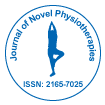开放获取期刊获得更多读者和引用
700 种期刊 和 15,000,000 名读者 每份期刊 获得 25,000 多名读者
索引于
- 哥白尼索引
- 谷歌学术
- 打开 J 门
- Genamics 期刊搜索
- 学术钥匙
- 安全点亮
- 参考搜索
- 哈姆达大学
- 亚利桑那州EBSCO
- OCLC-世界猫
- 普布隆斯
- ICMJE
有用的链接
开放获取期刊
分享此页面
抽象的
Prevalence of Risk of Fall in Community Dwelling Pakistani Male Population over the Age of 65 years
Mariam Mehmood, Muntaha Mushtaq, Nimra Ansa and Arooj Jilani
Introduction: Falls are very common in elderly population aged above than 65 years due to the physiological changes in the body, which can reduce the health related quality of life and may lead to morbidity and mortality. Aim and objectives of study: 1) To prove that increasing age solely can be a risk factor for individuals in the absence of any major ailment. 2) To measure the overall prevalence of risk of fall in general population to know how big the problem is 3) To categorize the fallers in 3 groups low, medium and high riskier group thus to give specific high risk prevalence rate along with identification of those who specifically have high risk so that they can intervene accordingly in future. Procedure: 77 subjects meeting inclusion criteria were taken. Timed up and go test was used at first to identify subjects who were in general having risk. Then to find out association between incrementing age and increased prevalence of risk of fall, these subjects were then grouped in to three; young old (<70 years), old or middle old group (70-79 years) and very old group (>80 years). Elderly fall screening test (EFST) questionnaire was then implemented for risk categorization. Part A of the questionnaire was used which comprised a total of 5 closed ended questions giving a score for each component. Subjects were categorized on the basis of scoring; those between 0-1 as low risk, between 2-3 as medium risk and 4-5 as high risk. Results: Overall, there is a prevalence rate of 44.16% of fall in community dwelling older adults over the age of 65 as measured by TUG. While the high risk prevalence rate which was determined by EFST was 12.04% (27.27/100 × 44.16). Conclusion: Aging solely can be a major risk factor for fall in community dwelling healthy and independent older adults having no major illness. It was confirmed that with incrementing age, most subjects of the very old group tend to lie in high risk category (12/22 subjects). Contrary to that, only few subjects of the young old group lied in the high risk category. They tend to lie mostly (17/25 subjects) in the low risk category.

 English
English  Spanish
Spanish  Russian
Russian  German
German  French
French  Japanese
Japanese  Portuguese
Portuguese  Hindi
Hindi